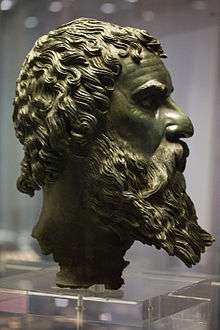Seuthes III

Seuthes III (Ancient Greek: Σεύθης) was a ruler of the Odrysian kingdom of Thrace from c. 331 BC to c. 300 BC.
Historical background
After the campaigns of Philip II in 347–342 significant part of Thrace had been dependent to Macedon. After Philip's death in 336 BC, many of the Thracian tribes revolted against Philip's son Alexander III the Great, who waged a campaign against and defeated the Getae and King Syrmus of the Triballi. All other Thracians sent troops to join Alexander's army.
Life
Seuthes revolted against the Macedon about 325 BC, after Alexander's governor Zopyrion was killed in battle against the Getae. After Alexander died in 323 BC he again took up arms in opposition to the new governor Lysimachus. They fought each other to a draw and each withdrew from battle. Ultimately Seuthes was compelled to acknowledge the authority of Lysimachus, by then one of Alexander's successor kings. In 320 BC, Seuthes III moved the Odrysian kingdom to central Thrace and built his capital city at Seuthopolis (Kazanlak), present day Bulgaria. In 313 BC he supported Antigonus I in the latter's war against Lysimachus, occupying the passes of Mount Haemus against his overlord but was again defeated and forced to submit.
Tomb of Seuthes III
The Tomb of the Thracian King Seuthes III is situated in the Golyamata Kosmatka mound, at a distance of 1 km south from the town of Shipka north from the town of Kazanlak. It was discovered in 2004. The Tomb was built in the second half of fifth century BC. Items found inside included the golden crown of the ruler, a golden kylix (shallow wine cup), knee pads and a helmet, and applications for horse tackle, all exhibited in the historical museum of the town of Kazanlak. Remarkable is the bronze head of the statue of Sevt III buried ritually in front of the façade, which is quite detailed. It is an important evidence of the Thracian Orphic rituals.
The tomb temple consists of a corridor, an anteroom, a round chamber with high tholos cover, and a rectangular chamber, constructed as a sarcophagus from two monolith blocks, one weighing more than 60 tons. The three halls are built of rectangular stone blocks and are covered with slabs. A two-winged marble door closes the entrance to the round chamber. The upper plains of the wings are decorated with images of the god Dionysus, who in the east part embodies the sun and in the west the earth and night.
The ritual couch and the ritual chamber are placed in the rectangular chamber. They were covered with fabric made of a golden thread, after that a splendid funeral of the ruler was performed. Above the phial, the jug, and the helmet was inscribed the name of Seuthes, which proves that in the beginning of third century BC here was buried Sevt III, the famous Thracian ruler of the Odrysian kingdom.
The capital of his kingdom, called Seuthopolis, is situated at about ten kilometers southwest from the tomb, on the bottom of Koprinka dam. The head of the statue of Seuthes is buried in the tomb, and it was placed on a pedestal in the capital Seuthopolis.
The personal belongings and the gifts, needed for the afterlife of the ruler are carefully placed in the chamber. After the burial the entrance of the round chamber and the anteroom were blocked, the horse of the ruler was sacrificed, and the corridor was ritually set on fire.
The tomb is a part of the Valley of the Thracian Kings, which also includes the Kazanlak tomb, as well as the tombs and the temples found in the mounds Goliama Arsenalka, Shushmanets, Helvetsia, Grifoni, Svetitsa, and Ostrusha.
References
| Seuthes III Born: Unknown Died: Unknown | ||
| Preceded by Teres II |
King of Thrace 331–300 BC |
Succeeded by Cotys II |